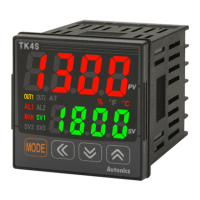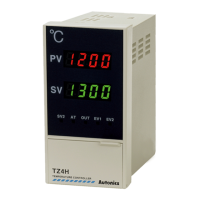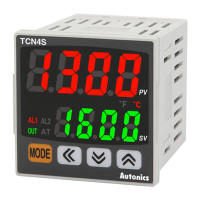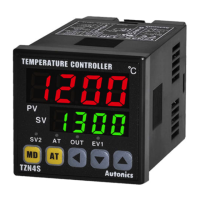6 Parameter Settings and Functions
© Copyright Reserved Autonics Co., Ltd. 59
6.1.5 Input correction [PAR3 → IN-B]
This feature is used to compensate for input correction produced by thermocouples, RTDs, or
analog input devices, NOT by the controller itself.
The Input correction function is mainly used when the sensor cannot be attached directly to
controlled objects. It is also used to compensate for temperature variance between the sensor's
installation point and the actual measuring point.
Parameter Setting range
Unit
PAR3 IN-B
-999 to 0999 (temperature H, analog)
0000
℃/℉/-
`9(9 to 99(9 (temperature L)
If the controller displays 78℃ when the actual temperature is 80℃, set the input correction [IN-
B] as ‘002’ in order to adjust the controller's display temperature to 80℃.
If present value after input correction is out of the input range by each input sensor, it displays
‘HHHH’ or ‘LLLL’.
Make sure that an accurate temperature variance measurement is taken before set values of
input correction. An inaccurate initial measurement can lead to greater variance.
Many of today's temperature sensors are graded by their sensitivity. Since higher accuracy
usually comes at a higher cost, most people tend to choose sensors with medium sensitivity.
Measuring each sensor's sensitivity correction for input correction feature in order to ensure
higher accuracy in temperature reading.
6.1.6 Input digital filter [PAR3 → MAvF]
It is not possible to perform stable control if the present value (PV) fluctuates because of fast
changes of input signal. Using the Input digital Filter function can stabilize PV to realize more
reliable control.
Parameter Setting range
Unit
PAR3 MAvF 00)1
12)0
)1
If the input digital filter is set to 0.4 sec., digital filtering is applied to a sampling value collected
over 0.4 sec. (400 ms).
When the input digital filter is used, present value (PV) can vary from the actual input value.

